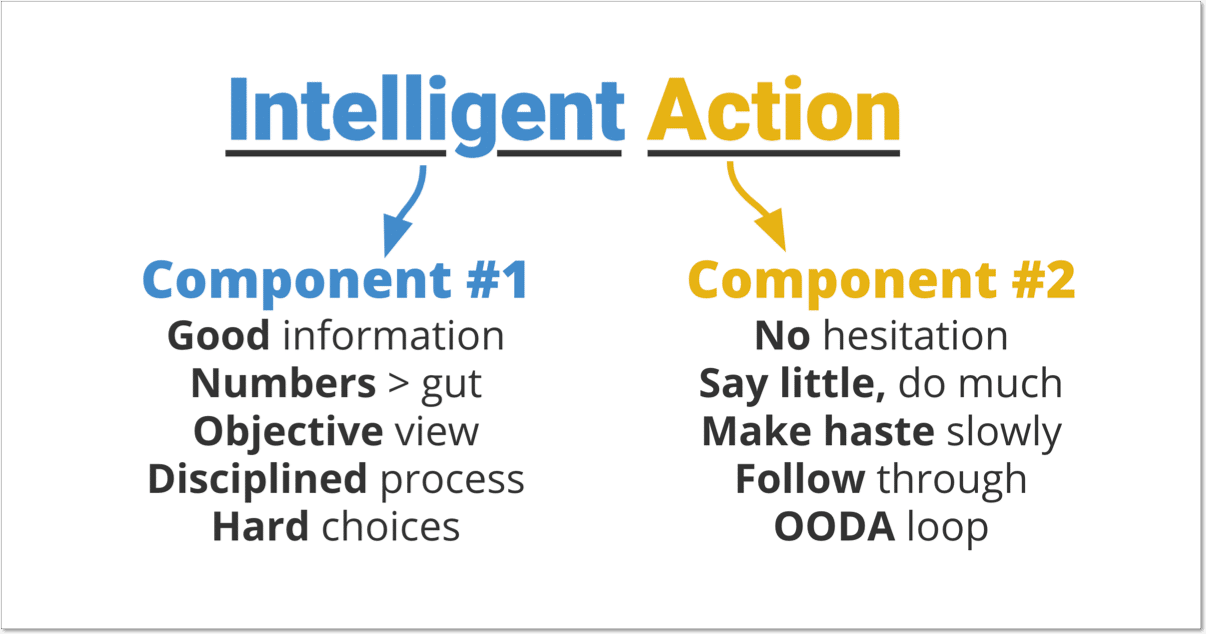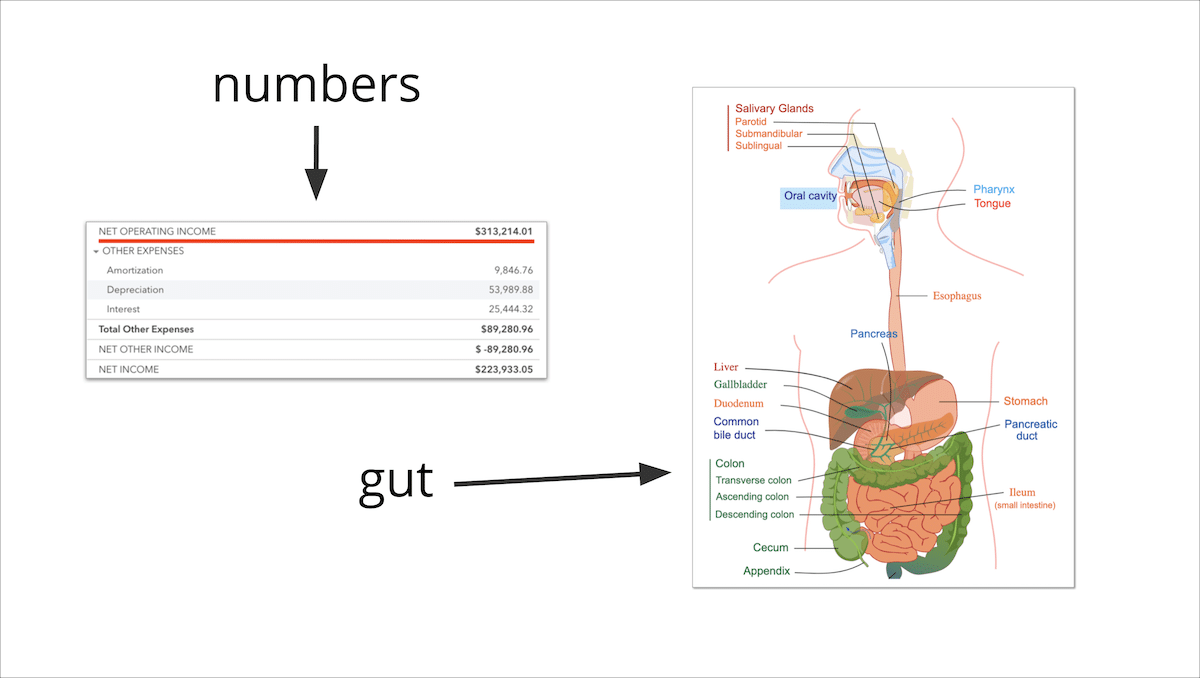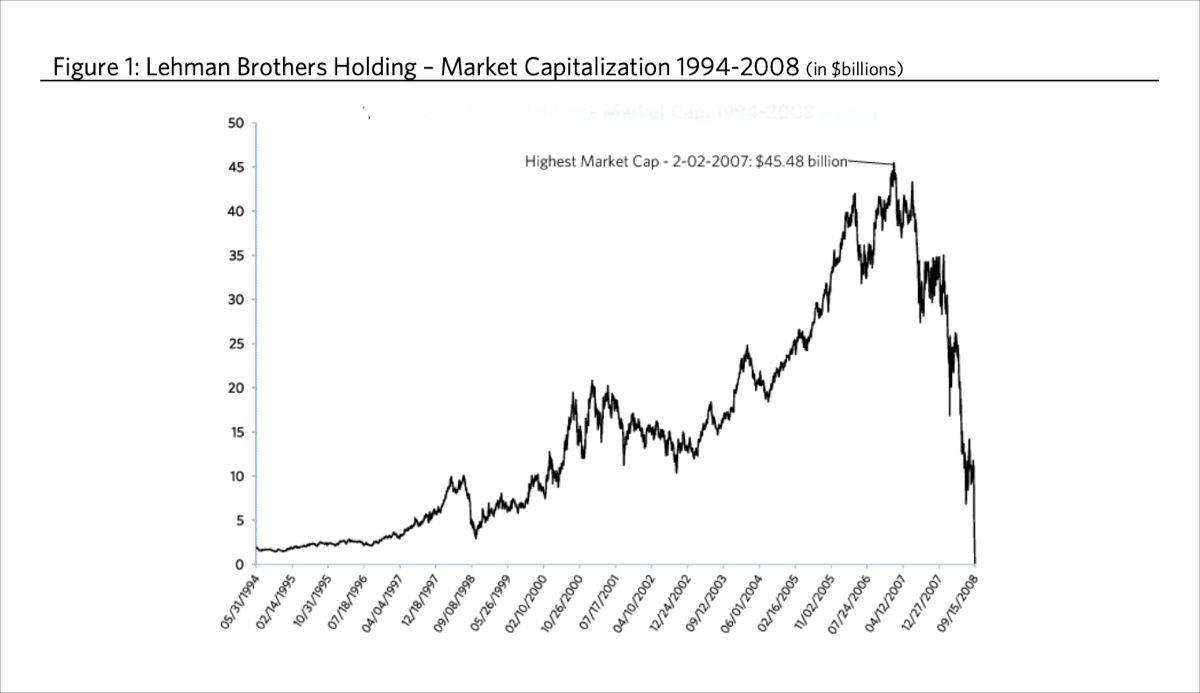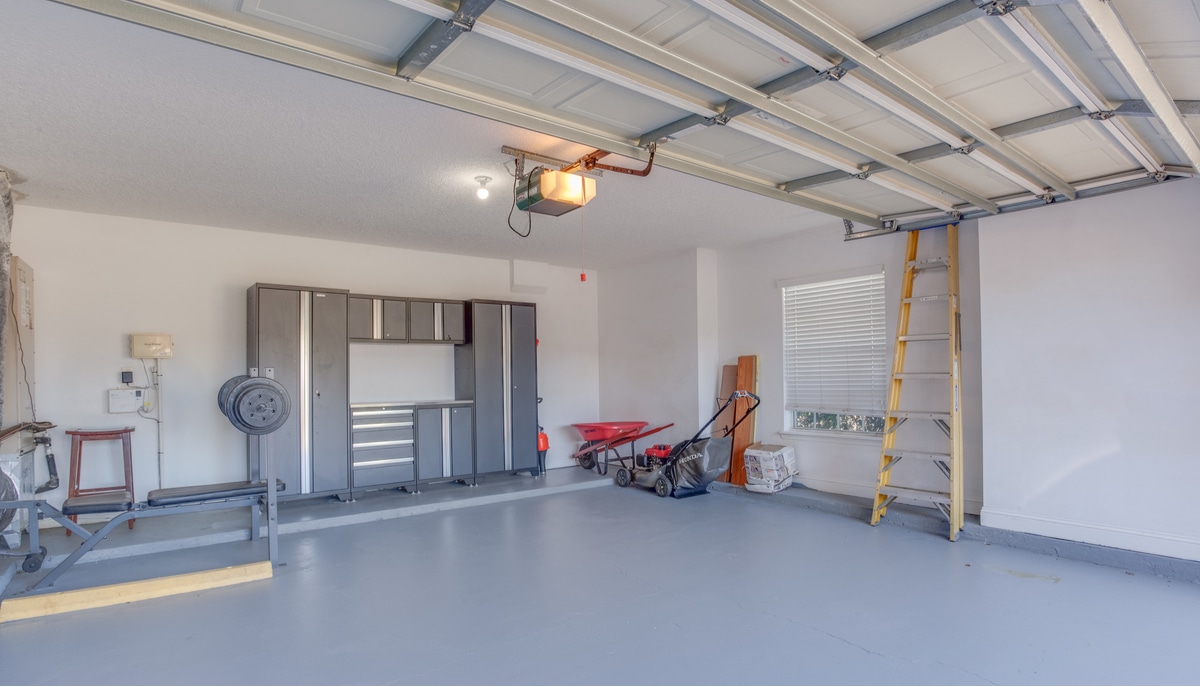Entrepreneur and business philosopher Keith J. Cunningham has a theory.
It’s a bit advanced, so bear with me here.
His magnum opus?
Smart people do dumb things.
Pow! He goes on (from The Road Less Stupid):
Here’s the proof: How much money would you have right now if I gave you the ability to unwind any three financial decisions you have ever made? Write that number down…
When you stop to think about it, what sabotages our dreams and causes most of our problems (and ensuing dumb tax) is our excessive optimism and emotional belief in magic pills, secret formulas, and financial tooth fairies…
Operators react and sweat.
Owners think and plan.
Chew on that one for a bit.
Now we’ll go deep into the decision-making component (the intelligence) of Intelligent Action.
From our original definition…

Ultimately, we want to answer the question:
What makes a good decision?
The outcome of this exercise?
Yes, make progress.
Yes, make the correct moves.
Yes, move the business forward.
But even more importantly, as Cunningham so eloquently outlined for us: AVOID THE DUMB TAX.
So first up…
Intelligence Part 1: Good Information
What informs good decision-making in the brewery?
First, let’s recognize that both high-level key ownership decisions (where to invest working capital this year) as well as the on-the-ground day-to-day decisions (which order should we run the next 3 batches?) are highly specific and concrete…
Both require a highly specific set of information in order to make them “intelligent.”
So we don’t need ALL of the information ALL of the time.
We just need the RIGHT information at the RIGHT time.
That means that before you go printing off reports and focus-grouping the crap out of your team:
- Identify the decision-making scenario at hand.
- Discuss what pieces of information would give you what you need to get clarity.
- Then, go about collecting that information.
Example: Taproom buildout or capacity increase + distribution push?
We just recently spoke with a small brewery (just under 1,000 BBL/year volume) that’s just starting to make their way into growth territory, working with a 90/10 taproom/distro split.
Their big question:
We’re profitable and we have some working capital available.
Should we spend it on a taproom buildout to increase our square footage with a deck area and focus on getting more volume through?
Or should we invest in a new set of tanks to support a capacity increase along with a part-time sales rep to push into new distribution territory?
The problem here is threefold:
- They’re not sure exactly what should be the deciding factor between the two options and don’t know what information they should be using to make the decision.
- They’re not sure if they’re missing other potential options outside of the two that they’re considering that could be a better match for where they want to take the brewery.
- Finally, because there are three owners, all with a seat at the decision-making table. Well, we know what typically happens here. A lot of arguing, little action, half-assed results.
(By the way, on that last point… I took three discovery calls last week that all started the same way: “Well the leadership does not exactly see eye to eye on the topic…” We’ll circle back to this later in the week.)
For now, let’s tackle the first problem: the information deficit.
Now on the face of it, expanding the drinking area to an outside space sounds like an excellent plan of action… in general. It opens the customer base to not only humans (big and small) but animals. It also may give the customer a direct line of sight to the food vendor there that day! More revenue = winning.
But…
- What if the landlord at the current location just jacked up the rent, and they were considering moving anyway?
- What if they have another potentially more lucrative location in their sights that could be justified by aggressive distribution expansion?
- What if they have investors interested in growing the top line and willing to fund additional expansion efforts once the distribution channels are proven out?
Here’s some of the information this trio should look to bring to the table in order to have a productive discussion:
- Finance: How much is each option going to cost and what’s the expected payback period? Give a best case and worst case estimate. Project out the implications of those scenarios on next year’s P&L and cash flow statement.
- Operations: What impact would this have on the taproom as the buildout happens? What additional staff support is needed? What’s our confidence level in increasing taproom traffic under the first option? What’s our confidence level going the distribution route? Who would we hire to fill the sales role?
- Values and vision: Where do each of us want this thing to go? Do we have an exit strategy and is this in line with the plan? Does either choice better represent our vision for the brewery?
- Constraints and context: What do we need to keep in mind with limitations on the current location? What contractual obligations are involved in the distro option? Are there any implications with our investor pool and their likelihood to support us moving forward?
Another example: What might “good information” look like for a brewery’s decision in the 5k+ BBL/year category, you ask?
We’ve needed to do this forever, but have finally decided to bite the bullet. How do we set our sales team’s field budget?
While this spend is unpopular among owners, it is helping the brewery where it is most needed. Here’s what you might start with:
- Audit historical spend and requests. What have our reps been spending on? What have they asked for?
- Investigate with the team and determine whether sales opportunities have been left on the table due to spending constraints.
- Analyze the number of CE’s a rep is responsible for.
- Assign an amount for each CE and test the scenario. Does $2/CE make sense? Does .50/CE make sense?
Alright… that should do it.
Ask yourself what decisions you and your leadership have on the table that would benefit from some high-quality information.
What would it take to collect that information?
Next up…
Intelligence Part 2: Numbers > Gut
Ahhh, yes!
Numbers… my favorite topic.
And true to form, I actually write and speak about it a great deal…
So we’ll keep it short and snappy.
Takeaway: Numbers > gut when it comes to Intelligent Action.

Here are the key points to keep in mind:
- First, your numbers have to be good enough to trust. Otherwise it’s inevitable that you’ll default to your gut. If your numbers make you dizzy, it’s probably because they’re either wrong or in the wrong format to be digestible. Funny, any brewery owner in the land can tell me minute over minute growth or decline in their taproom… because Square makes it so damn easy. Start with making sure your financials are legible, if they dont look right… they prob aren’t.
- Second, identify which numbers you need to look at. Then, compare. Without a comparison point (last month, last year, the SBS benchmarks… wink, wink) it’s hard to know heads vs. tails.
- Third, make the commitment. Part of making the choice to shift from gut to number is really about just that: making the choice. This is regardless of your size or age. It’s the way of the professional. At a certain point, you need to simply decide to set aside the emotion and allow the numbers to prevail.
Can you make that commitment?
(That was rhetorical. I know you can.)
Intelligence Part 3: Objective View
Earlier, we introduced a decision-making scenario:
We’re profitable and we have some working capital available.
Should we spend it on a taproom buildout to increase our square footage with a deck area and focus on getting more volume through?
Or should we invest in a new set of tanks to support a capacity increase along with a part-time sales rep to push into new distribution territory?
We first considered what “good information” might look like for the three owners faced with making the choice.
In the previous section, we explored what it takes to fight back the urge to ignore the numbers and go with the gut.
And so now we’ll circle back to the second problem I initially outlined:
They’re not sure if they’re missing other potential options outside of the two that they’re considering that could be a better match for where they want to take the brewery.
And this brings us to the third portion of our Intelligent Action decision-making discussion.
This one is a biggie.
Because if you don’t know if you are answering the right question in the first place…
You could be enthusiastically flying back-asswards in the opposite direction of where you need to head next.
Again back to Keith Cunningham:
When we get stuck, we tend to think the reason is because we don’t have the right answer. My experience is that finding the “right” answer is rarely the problem. What keeps us stuck are inferior questions that produce tactical or unattractive choices.
So ultimately we want to know:
Are we even asking the right question?
I find that when a serious decision like this is presented to founders, walls go up.
The decision-making starts with the gut from the start and rarely makes it to the numbers… and it’s because they get locked into unexamined choices before they even have a chance to start the decision-making process.
- The spouse’s friend told them to expand the taproom.
- The lead investor pushes for the distro expansion.
- Distributors call from afar, planting the seed early before they’ve had a chance to consider the implications.
When you’re stuck in the day-to-day operations of the brewery, it’s often a herculean task to step outside of chatter. But it’s exactly what needs to be done in order to make winning decisions.
Avoiding the narrow frame
In Decisive: How to Make Better Choices in Life and Work, Chip and Dan Heath call this “avoiding a narrow frame.” Three suggestions they have for breaking out of it:
- Learn to distrust “whether or not” decisions.
- Run the Vanishing Options Test: You cannot choose any of the options you’re considering. What else could you do?
- Find someone who’s solved your problem. Look for competitive analysis, benchmarking, best practices, and objective advisors.
So back to our scenario…
We very well may be setting up a false dichotomy by framing the decision around taproom buildout vs. capacity increase and distribution push.
Yes, run the numbers on these options.
But also, once you’ve done your homework on the baseline choices, ask the hard questions to inject objectivity into the mix:
What are the other options?
What are the hidden opportunity costs?
Who can we bring in to provide objectivity?
For example, you might realize…
- You’re not actually maximizing the existing taproom square footage, which means the expansion ain’t gonna move the needle. Those funds may have more impact going towards monthly can releases and a savvy designer with a penchant for guerrilla marketing.
- The distribution opportunities on the table will kill profitability, and that self-distribution is an intermediate option that would allow the brewery to expand more conservatively, while building a local base of distro volume and maintaining profit margin.
- That you’re not the first. Other similarly sized breweries, with a similar history, have been down this road before. You can study their trajectory from afar… or better yet buck up and ask for their advice. All founders loooovvve giving advice… especially if you stroke their ego 🙂
- That you should speak to the restaurateur down the block to gain some additional perspective on what the long-term implications of a new buildout would be. Or the local realtor with their ear to the ground. Or the seasoned entrepreneur in a different industry who can get some fresh eyes on the problem.
Moral of the story:
Step outside of the false dichotomy you may have locked yourself into, and open it up to the objective view.
As the Heaths put it:
Why generate your own ideas when you can sample the world’s buffet of options?
Hard to argue with that.
Intelligence Part 3: Disciplined Process
Profits are most certainly an accident without process.
Profits will be temporary without process.
Both of these are lines from a 2014 blog post of mine.
And no, I won’t be linking to it… we’ve come a long way since then 🙂
But the principle is as true as it’s ever been. I’ve only grown in my conviction over time, and I see this play out every day in the craft ecosystem we get the privilege to participate in.
Yes, I am saying if you have viral beers releases and remarkable cash flow, this will eventually go away without process.
And the same thing goes for decision-making as well.

Sticking to numbers > gut is doomed to failure if you just try to white-knuckle your way through it. So how does the leadership team actually go about making the decision?
The Disciplined Process
Every part of the brewery needs processes. You’ve heard me preach about this for days. The back office, operations, sales, and yes… even leadership decision making.
The alternative is decision making by authority. Or, as I like to call it, “putting out fires.” As we’ve seen before, this is one of the core root causes that leads to leadership burnout. It’s one of the central bottlenecks to growth.
Decision-by-committee is also doomed to failure. Sitting around the kumbaya table, taking votes, and participating in other democratic-looking, consensus-based activities is a recipe for wheel-spinning, passive aggressive sabotage, and slow-as-molasses forward progress.
Instead, we must follow a process, and leadership must lead the charge. Specifically, define the following:
- Who drives it? Who is responsible for keeping the decision-makers moving forward and driving to a result? This should typically be the most regimented member of the team who can be trusted to redirect tangents and keep the process moving along. They need to make sure the information is collected, the meetings are scheduled, and decision deadline is upheld.
- Who gets a say? Who is responsible for getting the good information and objectivity into the mix? Leadership yes. But also key employees, stakeholders, and outside advisors. Identify who needs to have input before you get ahead of yourselves.
- Who is the devil’s advocate? Of those people who get a say, who gets the task of ripping your overly-optimistic plan to shreds? This person should be disagreeable enough to stand up to the strong personalities driving the decision forward, and have enough authority to make you question what you’re even doing here in the first place. This is critical.
- Who owns it? Who is the ONE person ultimately responsible for making the final “yes/no” decision? This may feel uncomfortable for those who have co-founders and multiple partners… but a task assigned to two people is a task assigned to no one. Figure out who owns the decision and stick to it.
Let’s apply this to our taproom vs. distro example.
First, the “driver” brings the following information to the table:
- What will it cost?
- What is the benefit to the brewery?
- What is the payback period?
- What are the steps to execute?
- How long should it take?
With that in hand they schedule (3) leadership meetings:
- One to present the idea
- One to ask questions
- One to decide
And in-between each member takes the presented ideas to the other parties who need to give their input and objective check.
Finally, make the decision. The decision owner gets the final say. Once the facts are presented, questions answered, make the choice and lay out next steps.
Is this a far cry from what usually happens? Yes.
Is that a good thing? Yes.
And finally, we’ll close this out with the most difficult part of all of this:
Making. Hard. Choices.
Intelligence Part 5: Hard Choices
An admission for you:
Up until now we’ve actually been discussing the easy stuff.
- Collecting information
- Trusting that information
- Ensuring objectivity
- Even making the decision itself
Feels good right?
Like finally cleaning out your garage, standing back with your chest puffed out, and letting out a smirk and a long exhale… admiring your handiwork.

Now yes, go ahead and pat yourself on the back for a job well done.
But all of that work means jack unless you’re willing to follow through when there’s a tradeoff that hurts…
And there ALWAYS is a tradeoff that hurts.
This is the last leg of the intelligence component of Intelligent Action, and it is the most important.
The will to make hard choices comes from a layer deeper than numbers or gut. It requires courage. And the willingness to face FOMO, backlash, and damaged egos.
- The courage to rearrange the org chart, knowing that no matter what the reasoning, a few employees will poo-poo you until the end of time.
- The willingness to absorb a phone call from a pissed investor after you just retracted from some of your markets and downgraded your expansion strategy that would have continued to spread the brewery, and your profits, too thin.
- The cojones to hold your Director of Sales directly accountable – in person, with no caveats or hand-waving – for taking the reins on driving to the critical CE targets the brewery needs to hit in the coming year.
Back to our taproom expansion example…
Assuming for a moment that they’ve decided to expand the taproom over increasing capacity, these guys have to be willing to cut off whatever attachment they have to the distro option.
Take the expansion idea out back, shoot it, and bury it.
If we open the door, even a crack, to second-guessing ourselves, it will hinder the progress of the project at hand.
And it doesn’t have to be harsh. It’s not that the tanks were a bad idea, they are just not a fit for the brewery’s current phase. Next year, they may find the idea back on the table as a no-brainer.
Remember this from earlier?

Protect and grow the asset… by making the hard choices.
The Brewery Benchmarks Assessment is our way of bringing Intelligent Action to life in the brewery.
In practice, BBA is designed to give you the ammunition to make these hard choices with confidence.
Because when you’ve…
- Collected and analyzed the best information available…
- Assembled the numbers needed to override the gut…
- Combined that analysis with the objectivity that comes from a 3rd party who’s seen it all…
- Walked through the tradeoffs and gotten to the decision-making table with your partners…
Your matter-of-fact level of decision-making conviction goes way, way up.
But…
Ultimately that hard choice is not one you can delegate.
You’ve got to – with the backing of a rigorous, intelligent process – simply bone up and make the move.
If you’re ready. If you have the will…
Then I encourage you to reach out and give it a go.
Next, we go behind the scenes.